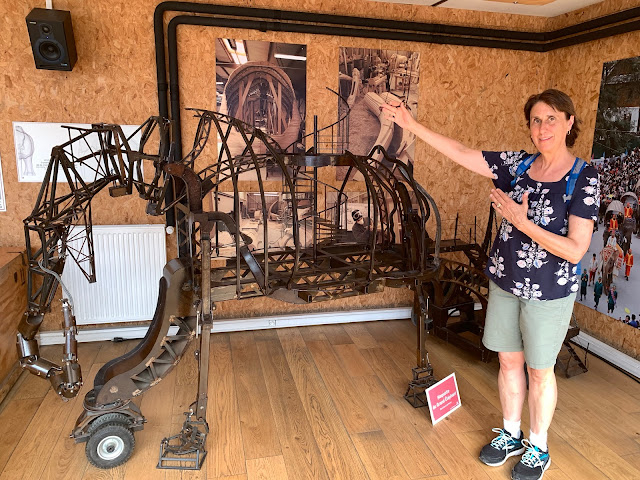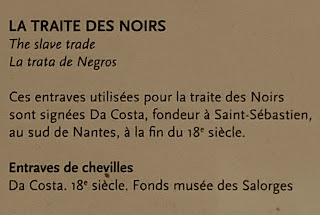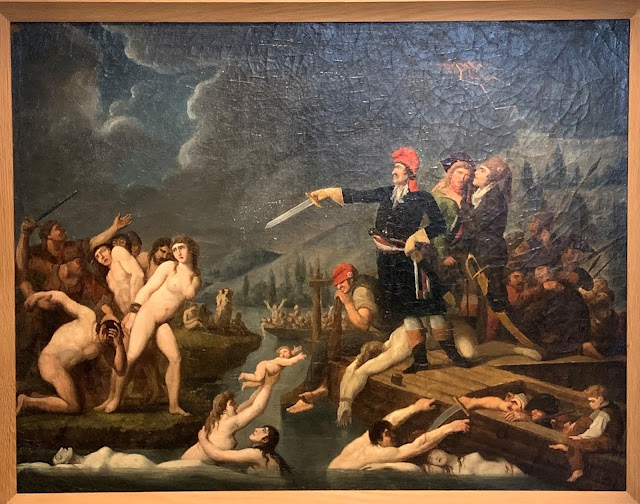Our road trip continues.
After visiting Saint-Malo and Rennes, we next visited Nantes and Angers.
Nantes:
Located on the Loire river, Nantes has a long history: It was a Roman town, it was conquered and ruled by the Dukes of Brittany, it was later joined to the Kingdom of France and it played a large role in the slave trade.
Sea trade fueled Nante's power and development over the centuries. Although 40 miles inland, Nantes is considered an Atlantic Ocean seaport. The Loire river allowed ships to travel inland while Nante's location provided some protection against attack.
We enjoyed our time in Nantes, lunching at a sidewalk cafe and strolling around the town. While strolling, we spotted something extraordinary--an oddly-shaped soccer field. Instead of rectangular, the field was semi-circular, ideal for players who can "bend it like Beckham".
We also visited the Château des ducs de Bretagne (Castle of the Dukes of Brittany) and an extraordinary place called the Les Machines de l’île.
A castle in the heart of Nantes once served as the home of the Dukes of Brittany.
 |
| Rob, Marie-Chantal and Sally at the Château des ducs de Bretagne |
The castle has been transformed into a museum dedicated to the history of Nantes. Let's enter across the ancient drawbridge and tour the museum.
The museum's collection is extensive, covering Nante's history from the middle ages to the 19th century. Below are some highlights about Nante's maritime and cultural histroy.
Nante's role in the slave trade is featured in the museum. We later learned that slavery is now an important topic in French schools.
 |
| Le Code Noir, or Black Code, regulated the French slave trade. |
Another dark period in Nante's history occurred during the French Revolution when a zealous revolutionary ordered the drowning of thousands of people, including priests, women and children.
The zealous revolutionary was Jean-Baptiste Carrier who later went to Paris, where he was convicted of war crimes and guillotined.
The museum also features an important industry in Nantes--baking cookies. Nantes is the home of LU, the famous maker of cookies, biscuits and other edible treats.
 |
| The LU tower is still standing. |
The most famous LU edible treat is a cookie called Le Petit Ecolier, a biscuit covered with chocolate. An image of a young schoolboy is imprinted in the chocolate. The original artwork appears below.
Le Petit Ecolier cookies are still popular in France. A package has occasionally found its way into our shopping bag.
Les Machines de l’île:
While in Nantes, we also visited a truly unique place, Les Machines de l’île. Located on the island in the river that once served as a shipyard, Les Machines de l’île is home to fantastic mechanical devices, like the ones pictured below. There was a huge spider, a flying crane, some walking insects, a slow-moving sloth, a hummingbird, flying geese, and Venus flytrap. All of the devices moved and some even carried passengers.


The most amazing device was very large. Below, Sally points to a scale model of the device.

The actual device is a huge self-propelled Elephant that carries dozens of passengers along a 1 kilometer path. Take a look.
The Elephant makes noise and even sprays water from its trunk. You can see the Elephant in action by clicking here or on the video below.
The fine folks at Les Machines de l’île have been creating fantastic devices since 2007, sending them all over the world, including to Burning Man in Nevada.
You might remember that we recently saw one of their caroussels in Brussels.
Thanks for visiting Nantes with us. Next stop . . .
Angers:
We stopped over in Angers for a short visit. We enjoyed dinner at a cafe on the main square and also visited Angers' cathedral, the Cathédrale Saint-Maurice d'Angers. Built during the 1000's-1500's, the cathedral sits atop the plateau where Angers is located. Consequently, the tall spires of the cathedral reach high into the sky.
The cathedral's interior is ornate.
 |
| The nave of the cathedral |
 |
| The altar of the cathedral, with a large ciborium overhead |
 |
| The pipe organ of the cathedral |
 |
| Close up of part of the pulpit |
In a side chapel, we spotted a shrine dedicated to two groups of martyrs. One group served under the patron of the cathedral, St. Maurice, a Roman officer. In the early 300's, Maurice and his soldiers, because of their faith, refused to massacre Christians. As a result, they were martyred. The other group included Catholic priest Guillame Repin and 99 other priests who refused to swear loyalty to the state-sanctioned church during the French Revolution. As a result, they were martyred.
 |
| Saint Maurice |
The stained-glass windows in the cathedral were lovely. Because we visited during late afternoon, the windows were beautifully illuminated.
When we visited, we were fortunate to hear the ringing of the cathedral's bells. Click on the video below to hear for yourself.
Thanks for visiting Angers with us.
Next stop, Saumur.



























































No comments:
Post a Comment